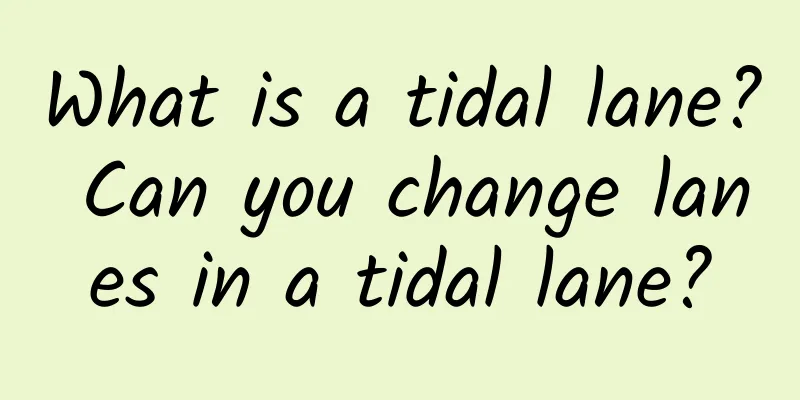What is a tidal lane? Can you change lanes in a tidal lane?

|
Many friends will encounter tidal lanes during the driver's license test. We will also encounter tidal lanes when driving on the road. What are tidal lanes? In order to alleviate urban congestion, many roads have used new lanes, namely tidal lanes, to divert traffic and promote smoother traffic. So how to drive in tidal lanes correctly? Let us learn more about tidal lanes! Contents of this article 1. What is a tidal lane? 2. Can you change lanes in a tidal lane? 3. How to drive on the tidal lane correctly 1What is a tidal lane?A tidal lane is a variable lane. It is a pilot project on urban expressways that allows the change of driving direction of a certain lane during different time periods on roads with conditions, based on the different traffic flow conditions in the morning and evening. For example, the number of lanes can be adjusted by changing the direction indicated by the lane lights and controlling the driving direction of the lanes on the main road. If the left-turn lane is very congested, but the straight lane is free of traffic, the traffic police can simply tap the remote control, and in less than a minute, the straight lane will become the left-turn lane, and the left-turn traffic jam will be resolved. The lanes can be changed at any time according to the traffic flow. Due to the tidal phenomenon of traffic, that is, the traffic flow in the direction of entering the city is large and the reverse flow is small every morning, while the traffic flow in the direction of leaving the city is large at night, which aggravates the congestion. In response to this situation, the traffic diversion and reconstruction adopts the method of variable lanes to organize traffic, that is, when there are many vehicles entering the city during the morning peak, the number of lanes in the direction of entering the city is increased, and the number of lanes in the direction of leaving the city is reduced; when there are many vehicles leaving the city during the evening peak, the number of lanes in the direction of leaving the city is increased, and the number of lanes in the direction of entering the city is reduced. 2Can I change lanes in a tidal lane?Tidal lanes are variable lanes. Based on the different traffic flows in the morning and evening, one or more lanes with vehicle travel directions that change at different times are set up on roads with conditions in the city. Traffic police can use handheld remote controls to control variable directional lane signs to adjust lane driving directions at any time according to on-site traffic conditions. If there are obvious traffic characteristics at the intersection and there are no emergencies, traffic police can also input the time for fixed sign conversion into the program in advance, and it will change automatically. In addition, the control center can also monitor the road conditions at the intersection through instruments and use remote control to control the signboards when appropriate. If the intersection signal machine is connected to a computer network, it can also be identified and automatically adjusted through an automatic recognition system. 3How to drive on the tidal lane correctlyBefore entering the tidal lane, you must check whether the indicator light turns green. Only when it turns green can you enter the tidal lane and wait to turn left. You cannot enter the tidal lane when the red light is on. When driving in a tidal lane, do not drive over the line, and do not enter the tidal lane and change lanes directly. You must wait patiently for the traffic light to turn green before you can use the tidal lane to make a left turn. When driving on a tidal lane, you must pay attention to the instructions on the signboards. Generally, there are time restrictions for driving on a tidal lane. For example, you can use the tidal lane during the morning rush hour and the evening rush hour, but not at other times. When the traffic volume in the tidal lane is too heavy, or the tidal lane is no longer suitable for the traffic flow at the intersection due to changes in traffic flow, you must obey the on-site instructions of the traffic police and do not use the tidal lane at will. When passing through a tidal lane, pay special attention to the straight tidal lane, look at the traffic lights and then use the tidal lane to pass to avoid running a red light. When driving, if you encounter a tidal lane, be careful to avoid vehicles making U-turns, because the left-turn entrance of the tidal lane often intersects with the U-turn position, so be sure to avoid it in time. |
<<: Why can we use tides to generate electricity? What causes tidal phenomena?
>>: Do you know these 15 small signs of cancer?
Recommend
What color are normal pistachios? Will eating pistachios cause internal heat?
Pistachios, like other nuts, are rich in protein ...
Can pregnant women take VC effervescent tablets?
The body of a pregnant woman is relatively weak, ...
What are the benefits of foot bathing for gynecological treatment
Gynecological diseases are diseases that are very...
Back pain at 14 weeks of pregnancy
When the pregnancy reaches the 14th month, the be...
What happens if there is blood again 7 days after the menstrual period ends?
There will definitely be bleeding from the lower ...
20-year-old standard nipple
Breasts are an important feature of women. Women ...
How can women nourish the kidneys effectively?
Having a good kidney is vital for us. Both men an...
Are rural cooperative medical cards and social security cards the same? What do I need to bring to get my employee social security card?
The social security card is a comprehensive card ...
What is the best time of day to soak in hot springs? Can you soak in hot springs frequently?
Hot spring baths can not only relax muscles and j...
How many times can I have sex when I am 5 months pregnant?
We all know that it is best not to have sex when ...
Is it good to grow flowers in pots? Why does it leak when growing flowers in pots?
With the improvement of living standards, more an...
What are the symptoms of chronic pyelonephritis in women?
Chronic pyelonephritis is a common disease among ...
What causes breast pain?
Most female friends suffer from gynecological dis...
What is the best time for women to check for infertility?
Nowadays, due to the pressure of work and surviva...









